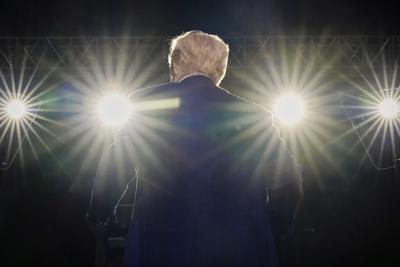It appears that U.S. President Donald Trump isnŌĆÖt intent on waging a global trade war, after all.
Most dramatically, the U.S. slashed its recently imposed 145 per cent tariff on imports of Chinese goods to 30 per cent for 90 days as the worldŌĆÖs two largest economies continue to negotiate more favourable trade arrangements.
That follows a new trade deal reached last week between the U.S. and the U.K.
The Trump administration is believed to be in negotiations with dozens of trading partners, including the European Union (EU).
The Trump climbdown from what the Wall Street Journal described as ŌĆ£mutual assured trade destructionŌĆØ is obvious good news. It represents an estimated $300 billion (U.S.) in tariff relief.
It doesnŌĆÖt yet provide relief for Canada, though. U.S. tariffs remain in place for imports not compliant with the Canada-United States-Mexico Agreement (CUSMA) and on steel, aluminum, automobiles and energy products.
The Retail Council of Canada said it ŌĆ£welcomes this development, but weŌĆÖre not popping the champagne just yet.ŌĆØ It notes that remaining Trump tariffs continue to disrupt global supply chains.
And Chinese suppliers are likely to increase prices to cover the 30 per cent tariff, raising prices in Canadian as well as U.S. stores.
Consumers are learning just how reliant they are on China, which is the leading supplier to North America of baby strollers, microwave ovens, toasters, dishes, fireworks and electric vehicle batteries.
China has conceded little in exchange for the U.S. climbdown, suggesting that Canada can restore healthy U.S. trade relations with a minimum of concessions.
China has agreed to replace its 125 per cent counter-tariff against the U.S. with a 10 per cent surtax. But Beijing has not addressed problems that have long plagued the U.S.-China trade relationship.
China has not removed barriers to U.S. companies, for instance. It continues to heavily subsidize key industries like electric vehicles in which China seeks world dominance. And China is still suspected of chronic intellectual property theft.
ŌĆ£Trump has achieved absolutely nothing from China for all the chaos he generated, zilch,ŌĆØ Harvard economist Dani Rodrik posted to Bluesky.
The challenge for Prime Minister Mark Carney is to prepare concessions that enable Trump to take a victory lap after lifting his tariffs on Canada.
Those could include adjustments to CanadaŌĆÖs supply management system for dairy, poultry and egg products, which Canadian consumers would welcome. They could also include changes to CanadaŌĆÖs digital services tax regime, another long-standing U.S. trade irritant.
In the meantime, there is relief that the U.S. has stepped back from punitive tariffs on trading partners worldwide including Bangladesh (37 per cent), Sri Lanka (44 per cent) and Vietnam (46 per cent).
Only a few weeks ago, on April 2, Trump unveiled planned tariffs on about 100 countries, a trade offensive so extensive it included uninhabited volcanic atolls hundreds of kilometres from Antarctica.
The Trump administrationŌĆÖs sudden massive reversal was forced on it by U.S. retail CEOs warning of empty shelves at Walmart, Costco and Home Depot.
North America wholesalers and retailers were refusing to take delivery of imports from Asia-Pacific destined for the U.S. and Canada, believing they could not pass tariff-related extra costs to their customers.
CEOs across the U.S. economy have been anticipating tens of billions of dollars in losses from lower sales and additional costs in managing disrupted supply chains.
And widespread consumer angst over Trump-induced price increases posed a risk to the RepublicansŌĆÖ continued control of Congress after next yearŌĆÖs midterm elections.
Last week, the Bank of Canada (BoC) warned that a prolonged trade war with the U.S. could slow the economy and increase unemployment.
ŌĆ£Tariffs and uncertainty have sharply reduced prospects for global economic growth,ŌĆØ the BoC said in what it called a worst-case scenario. ŌĆ£And financial markets have been rocked by chaotic policy announcements and reversals.ŌĆØ
That dismal scenario seems less likely now, though experts warn that we are witnessing a de-escalation of trade hostilities, not a lasting peace.
CanadaŌĆÖs defiance in standing up to Trump has served it well. Trump no longer seems invincible.
To be sure, it took a collective effort to curb TrumpŌĆÖs zealous protectionism.
But a combination of U.S. consumers curtailing their expenditures, a repudiation of the Trump tariff regime by the financial markets, and punishing retaliatory counter-tariffs imposed by Canada, China and other major U.S. trading partners has brought Trump around to a semblance of trade sanity.
Mind you, TrumpŌĆÖs new universal 10 per cent tariff on all imports is still four times higher than the average U.S. tariff when Trump took office.
And the thaw could prove temporary. Nothing can be certain with the mercurial Trump.
But Trump is unlikely to embarrass himself again with another full-scale assault on world trade, which he would lose in spectacular fashion as he has just done.



























To join the conversation set a first and last name in your user profile.
Sign in or register for free to join the Conversation